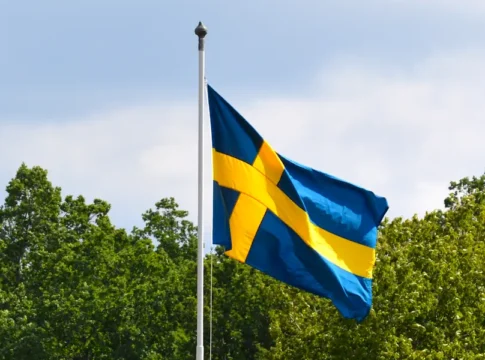 Photo: Bernt Fransson (CC0)
Photo: Bernt Fransson (CC0)Sveriges nationaldag: A Day of Swedish Pride and Tradition
Celebrate Sweden’s National Day on June 6 with flags, parades, and royal festivities. Join locals in Stockholm to enjoy music,…

Stockholm, Sweden’s capital, is a city brimming with history, culture, and breathtaking sights. One of the most intriguing stories related to the city is the origin of the term “Stockholm Syndrome.” This psychological phenomenon has captivated the world and all started at Norrmalmstorg, a square in the heart of Stockholm. If you’re planning a trip to Stockholm, Norrmalmstorg should be on your must-visit list.
The story of Stockholm Syndrome dates back to August 1973, when an attempted bank robbery at Kreditbanken in Norrmalmstorg turned into a six-day hostage crisis. Jan-Erik Olsson, a convict on parole, took four employees hostage in the bank’s vault. During their captivity, the hostages began to develop a psychological bond with their captor, even defending him after their release. This unexpected emotional connection between captor and captive puzzled the world and gave rise to the term “Stockholm Syndrome.”
The harrowing events that took place during the Kreditbanken siege are both dramatic and complex, shedding light on the intense psychological dynamics that led to the coining of Stockholm Syndrome.
On August 23, 1973, Jan-Erik Olsson entered Kreditbanken armed with a submachine gun, firing shots into the air and declaring, “The party has just begun!” He then took four bank employees—three women and one man—hostage. His demands included a getaway car, three million Swedish kronor, and the release of his friend, Clark Olofsson, a fellow convict.
The police complied with Olsson’s demand to bring Clark Olofsson to the scene, hoping it would defuse the situation. However, Olofsson’s arrival only complicated the standoff. The two criminals barricaded themselves and the hostages in the bank’s vault, creating a tense and volatile environment.
During these days, an unexpected psychological phenomenon began to unfold. The hostages started to sympathize with their captors. One hostage, Kristin Enmark, famously told the Swedish Prime Minister Olof Palme over the phone that she felt safe with the robbers but feared the police might escalate the situation to violence. The hostages even began to critique the police efforts, believing that the robbers were protecting them from a greater danger.
On August 28, after extensive negotiations and the use of teargas, police forces finally breached the vault. Olsson and Olofsson surrendered without any harm coming to the hostages. When the crisis ended, the hostages were seen hugging and kissing their captors in gratitude, a bewildering sight that captured the world’s attention.
Despite the traumatic event, the hostages defended their captors in court. Clark Olofsson was initially convicted but later had his conviction overturned on appeal. Jan-Erik Olsson served time in prison for the incident. The hostages’ emotional bond with their captors was so deep that some kept in touch with them after the ordeal, further solidifying the occurrence of Stockholm Syndrome.
Experts have since analyzed the incident to understand why the hostages developed positive feelings toward their captors. The theory is that in the face of life-threatening situations, hostages may perceive acts of kindness, no matter how small, as significant, leading to a paradoxical emotional bond. This phenomenon has been observed in various hostage situations worldwide, making “Stockholm Syndrome” a crucial term in the field of psychology.
Norrmalmstorg is not just a historical site but a vibrant part of Stockholm that offers more than its storied past. Located in the bustling district of Norrmalm, the square is a perfect blend of historical intrigue and modern-day charm. Here’s what you can expect when you visit:
Start your journey by visiting the very bank where the infamous hostage situation took place. While the bank itself has changed over the years, the building remains a significant landmark that echoes the past. Plaques and information boards around the area provide insightful details about the events of 1973.
Norrmalmstorg is surrounded by high-end boutiques, eclectic shops, and gourmet restaurants. Whether you’re looking to indulge in some retail therapy or enjoy a sumptuous Swedish meal, the square offers a variety of options to cater to your tastes.
The square often hosts local events, street performances, and art exhibitions, making it a cultural hotspot. Take a leisurely stroll and soak in the lively atmosphere, or relax at one of the many outdoor cafes and watch the world go by.
Norrmalmstorg is easily accessible by public transport, with several bus and metro lines
stopping nearby. The square is also within walking distance from major attractions like the Royal Palace and Gamla Stan, Stockholm’s Old Town.
A visit to Norrmalmstorg offers not only a journey through time, but also a chance to delve into a significant period in psychological history, all while immersing yourself in the vibrant life of modern Stockholm. Whether you’re a history buff, a culture enthusiast, or just looking for a unique spot to visit, Norrmalmstorg offers something for everyone.
Don’t miss out on the chance to delve into the fascinating story of Stockholm Syndrome and its origins. Make Norrmalmstorg a highlight of your Stockholm adventure!
By weaving the compelling history of Stockholm Syndrome with the contemporary allure of Norrmalmstorg, you’ll leave with both memorable experiences and enriched knowledge of Stockholm’s unique past.
![]() Explore Norrmalmstorg
Explore Norrmalmstorg
![]() Norrmalmstorg
Norrmalmstorg